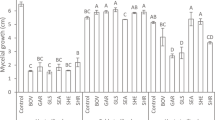Abstract
Qualitative enzyme assays were used as a tool to investigate the stability of freeze-dried mycorrhizal fungi. Both lyophilized (L) and non-lyophilized (NL) mycelia of individual isolates showed identical response for all the enzymes tested (nitrate reductase, protease, pectinase, and nuclease). All the isolates showed positive nitrate reductase activity, except two isolates of Thelephora terrestris (both L and NL). Both L and NL cultures of individual isolates showed substrate specificity (between gelatin and casein) for protease activity. Though both L and NL mycelia of all the culture isolates grew upon pectin substrate, there was no pectinase activity expressed. RNAase activity was variously exhibited (little activity, little growth–no activity, and no growth–no activity) by individual test cultures. The consistencies in growth and enzyme activity of the cultures before and after lyophilization imply the stability of the freeze-dried vegetative mycelium.
Similar content being viewed by others
References
Abbott, W.M. 1989 The physiology of renal preservation injury. I. Freezing injury and its modification. Cryobiology 5, 300-305.
Abuzinadah, R.A. & Read, D.J. 1986 The role of proteins in the nitrogen nutrition of ectomycorrhizal plants. I. Utilization of peptides and proteins by ectomycorrhizal fungi. New Phytologist 103, 481-493.
Colpaert, J.V. & Van Laere, A. 1996 A comparison of extra-cellular enzyme activities of two ectomycorrhizal and a leaf-saprotrophic basidiomycete colonizing beech leaf litter. New Phytologist 133, 133-141.
Duddridge, J.H. & Read, D.J. 1984 Modification of the host-fungus interface in mycorrhizas synthesized between Suillus bovinus (fr.) O. Kuntze and Pinus sylvestris L. New Phytologist 96, 583-588.
Giltrap, N.J. 1981 Formation of primordia and immature fruiting bodies by ectomycorrhizal fungi in culture. Transactions of the British Mycological Society 77, 204-205.
Giltrap, N.J. & Lewis, D.H. 1982 Catabolite repression of the synthesis of pectin-degrading enzymes of Suillus luteus (L.ex Fr.) S F Gray and Hebeloma oculatum Bruchet. New Phytologist 90, 485-493.
Guttenberger, M. 1995 The protein complement of ectomycorrhizas. In Mycorrhiza: Structure, Molecular Biology and Function, eds Varma, A.K. & Hock, B., pp. 59-78. Berlin: Springer-Verlag. ISBN 3-540-58525-7.
Hawkrworth, D.L. 1991 The fungal dimension of biodiversity: magnitude, significance and conservation. Mycological Research 95, 641-655.
Ho, I. 1987 Enzyme activity and phyto-hormone production of a mycorrhizal fungus, Laccaria laccata. Canadian Journal of Forest Research 17, 855-858.
Hutchinson, L.J. & Malloch, D.W. 1988 A verification protocol for cultural isolates of ectomycorrhizal basidiomycetes. In Canadian Workshop on Mycorrhizae in Forestry, eds Lalonde, M. & Piche, Y., pp. 121-124. Ste-Foy, Quebec: CRBF, Faculté de Foresterie et de Géodésie, Université Laval.
Kowalski, S. 1974 Zbiorowiska grazybow lesmego srodowiska glebowego wybranych drzewostanow sosnowych. Prace kom. Nauk roln. Les. (PTPN, Wydz. Nauk Roln. Les.) 38, 123-165.
Lindeberg, G. & Lindeberg, M. 1977 Pectinolytic ability of some mycorrhizal and saprophytic hymenomycetes. Archives of Microbiology 115, 9-12.
Marx, O.H. 1981 Variability in ectomycorrhizal development and growth among isolates of P. tinctorius as affected by source, age and re-isolation. Canadian Journal of Forest Research 11, 168-169.
Molina, R. & Palmer, J.G. 1982 Isolation, maintenance and pure culture manipulation of ectomycorrhizal fungi. In Methods and principles of mycorrhizal research, ed Schenck, N.C. Chap. 11, pp. 115-130. The American phytopathological society. St. Paul, Minnesotta, USA.
Paterson, R.R.M. & Bridge, P.D. 1994 Biochemical Techniques for Filamentous Fungi. IMI Technical Handbooks no.1. Wallingford, UK: CAB International. ISBN 0 85198 740 0.
Pegg, D.E. 1989 Viability assays for preserved cells, tissues and organs. Cryobiology 26, 212-231.
Ramsteldt, M. & Söderhäll, K. 1983 Protease, phenoloxidase and pectinase activities in mycorrhizal fungi. Transactions of the British Mycological Society 81, 157-160.
Read, D.J. 1991 Mycorrhizas in ecosystems. Experientia 47, 376-391.
Simione, F.P. & Brown, E.M. 1991 ATCC Preservation Methods: Freezing and Freeze-drying. Maryland, Rockville: ATCC Press. ISBN 0-930009-41-X.
Smith, D. & Onions, A.H.S. 1994 The Preservation and Maintenance of Living Fungi. Wallingford, UK: CAB International. ISBN 0 85198 904 7.
Sundari, K.S. 1999 Storage and Preservation of Mycorrhizal Fungi. PhD thesis, Barkatullah University, Bhopal, India.
Sundari, K.S. & Adholeya, A. 1999 Freeze-drying vegetative mycelium of Laccaria fraterna and its subsequent regeneration. Biotechnology Techniques 13, 491-495.
Tan, C.S. & Stalpers, J.A. 1991 Freeze-drying of fungal hyphae. Mycologia 83, 654-657.
Author information
Authors and Affiliations
Rights and permissions
About this article
Cite this article
Sundari, S.K., Adholeya, A. Retention of enzyme activity following freeze-drying the mycelium of ectomycorrhizal isolates. World Journal of Microbiology and Biotechnology 16, 373–376 (2000). https://doi.org/10.1023/A:1008984700163
Issue Date:
DOI: https://doi.org/10.1023/A:1008984700163




